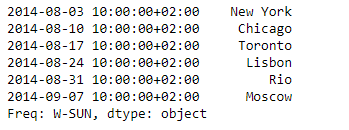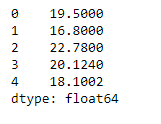Python Pandas Series.to_string()
Pandas系列是一个带有轴标签的一维ndarray。标签不需要是唯一的,但必须是一个可散列的类型。该对象支持基于整数和标签的索引,并提供了大量的方法来执行涉及索引的操作。
Pandas Series.to_string()函数渲染了一个字符串表示的系列。
语法: Series.to_string(buf=None, na_rep=’NaN’, float_format=None, header=True, index=True, length=False, dtype=False, name=False, max_rows=None)
参数:
buf : 要写入的缓冲区
na_rep :使用NAN的字符串表示,默认为’NaN’。
float_format :formatter函数,如果列的元素是浮动的,则应用于这些元素,默认为无。
header:添加系列头(索引名称)。
index : 添加索引(行)标签,默认为True
length:添加系列长度
dtype :添加系列dtype
name : 添加系列名称,如果不是无。
max_rows : 截断前显示的最大行数。
返回:格式化的字符串。
示例#1:使用Series.to_string()函数来呈现给定系列对象的字符串表示。
# importing pandas as pd
import pandas as pd
# Creating the Series
sr = pd.Series(['New York', 'Chicago', 'Toronto', 'Lisbon', 'Rio', 'Moscow'])
# Create the Datetime Index
didx = pd.DatetimeIndex(start ='2014-08-01 10:00', freq ='W',
periods = 6, tz = 'Europe/Berlin')
# set the index
sr.index = didx
# Print the series
print(sr)
输出 :

现在我们将使用Series.to_string()函数来为这个系列对象呈现字符串表示。
# render to string form
sr.to_string()
输出 :

正如我们在输出中看到的,Series.to_string()函数已经成功地将一个字符串表示法呈现给了给定的对象。
示例#2:使用Series.to_string()函数来呈现给定系列对象的字符串表示。
# importing pandas as pd
import pandas as pd
# Creating the Series
sr = pd.Series([19.5, 16.8, 22.78, 20.124, 18.1002])
# Print the series
print(sr)
输出 :

现在我们将使用Series.to_string()函数来为这个系列对象呈现字符串表示。
# render to string form
sr.to_string()
输出 :

正如我们在输出中看到的,Series.to_string()函数已经成功地为给定的对象呈现了一个字符串表示。
 极客教程
极客教程